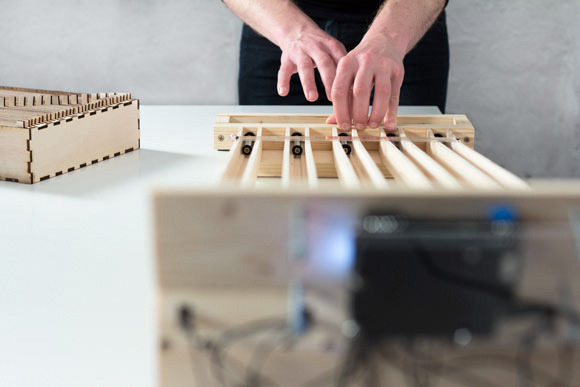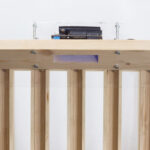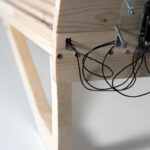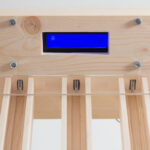A tribute to 5-bit Baudot code

Julian Hespenheide is an interaction designer based in Germany who submitted to Arduino blogpost a writing machine called émile. It’s an interactive installation created in collaboration with Irena Kukric, David Beermann, Jasna Dimitrovskais and using Baudot code – a binary 5-bit code, predecessor of ASCII and EBCDID – intended for telecommunication and electronic devices, representing the entire alphabet.
It runs on Arduino Uno and translates the bauds (/?b??d/, unit symbol Bd) into moving objects that are being sent over physical tracks in order to illustrate a simple computational process of 5-bit binary information transmission:
The machine was built in six days with four people. In our group we came to the conclusion, that not every process in a computer is really transparent and it already starts when you type a simple letter on a keyboard. To unwrap this “black box” of data transmission, we set our goal to build a small writing machine where you can literally see bits rolling around. After some research we got back to the beginnings of Telefax machines and data transmission using Baudot-code. We then quickly designed punchcards and mapped them to a slightly altered baudot code table and cut them with a laser cutter from 5mm plywood.
Whenever a marble hits a switch, a short timer goes off and waits for input on the other switches. If no other marbles are hitting those switches, we finally translate the switches that have been hit into the corresponding letter.
Take a look at the machine in action:




August 28th, 2015 at 12:24:21
its a good machine. well i just wanted to know that where could this be used in our daily life
August 28th, 2015 at 13:12:07
For a start, it can be used on Vimeo to make a nice clip. Furthermore, it’s kinetic art, a beautifully finished machine, great job!
August 29th, 2015 at 20:38:35
Unbelieable ! I was years ago a telegraph operator with the
Western Union Telegraph Co… I read the 5-unit (Murray Code
as we called it)… I read it like a book, and I have not forgotten it ! The old ‘blind’ perforators for punching the
5-unit tape and the old transmitters working at 50 baud
and you had to keep a loop going into the transmitter, so
you had to punch tape at more than 60, otherwise a bar
would lift the tape up and stop the loop and stop the
transmitter, which was sad then because it wasted the
undersea cable capacity (I still have pix and things over
all that !)… Rgds John Bolton bijoutronique@skynet.be
+++
September 3rd, 2015 at 14:58:14
This clever bit of kit looks as though it would make an excellent hands on, interactive technology museum display. Well done!
Like John B above, this project brought back many memories for me. My wife’s Aunt was in RAF communications in WW2 and used RTTY (Radioteletype). The incoming radio serial code would be punched into the paper tape by the radio receiver, which the operator then fed into a teletypewriter to print out the message. Like John, she could read BAUDOT straight off the tape. She was the first in her station to read of the armistice at the end of the war and was one of the first in Britain to know.
My father sat on a UK government committee that had to standardise the dimensions etc. of the 5 hole tape itself, for use with the “new” American computer equipment (PDP 1’s etc.) in the 60’s. He came home one day with a smile on his face. They had previously converted the tape dimensions from imperial to metric (Yes, we were metric that long ago!) and then had converted them back for American products. In the process a rounding up or down error had crept in, and the two sets of imperial tape measurements did not now match up!!
After my training in 1970, my first job was working on some aspects of development of the computer used in Royal Navy submarines. The input/output for this computer was a RTTY typewriter generating Baudot coded 5 hole paper tape. As you can imagine the paper tape had to be many tens of metre long to hold a program or data set. Many of these huge tapes made a roll of 400 mm or so in diameter, and were dreadfully difficult to handle. On a number of occasions the middle of a roll fell out and I had to carefully unroll and untangle the paper tape to be able to roll it up again. Of immense use to me was the fact that my lab was on the side of a cliff in Portland Naval base, several hundred metres above the sea. I dangled the tape out of the window which allowed it to become untangled and then safely rolled up again.
Rock on All!
September 15th, 2015 at 03:14:01
Hams (radio amateurs) still use RTTY for communication. Not as much as in the past, what with newer HF digital modes, but you still hear it from time to time.